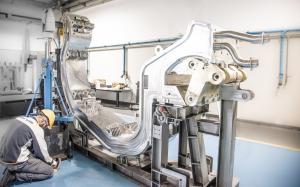Successful prototypes open way to series
Before embarking on the fabrication of the 54 complex steel structures that will form a ring at the bottom of the ITER machine—the divertor cassettes—the European Domestic Agency has been collaborating with industry on the development of real-size prototypes. This phase is now concluding, and the contract for the first series will soon be launched.
These U-shaped steel structures at the bottom of the vacuum vessel act as the chassis for components facing the most blistering heat of ITER operation—the divertor dome and inner and outer targets. The cassette bodies are also designed to resist transient electromagnetic induced forces as high as 100 tonnes, provide neutron shielding for the vacuum vessel, and host diagnostic systems and cooling water channels. There are more than a dozen design variants.
Since 2013 the European Domestic Agency—which is providing all 54 divertor cassettes to ITER as well as the inner vertical targets—has been working with industry to develop full-scale prototypes, a strategy that encouraged multiple suppliers to get involved and served to verify that the required quality could be achieved at acceptable cost.
Two European firms carried their participation through to the end—Walter Tosto in Italy and the French-Italian CNIM-SIMIC consortium. The final dimensional checks of the initial procurement program were completed a few weeks ago and cold/hot helium leak tests were successfully performed. With these results in hand, the European agency is preparing to issue a call for tender for the first series of divertor cassette bodies (not to exceed 20).


